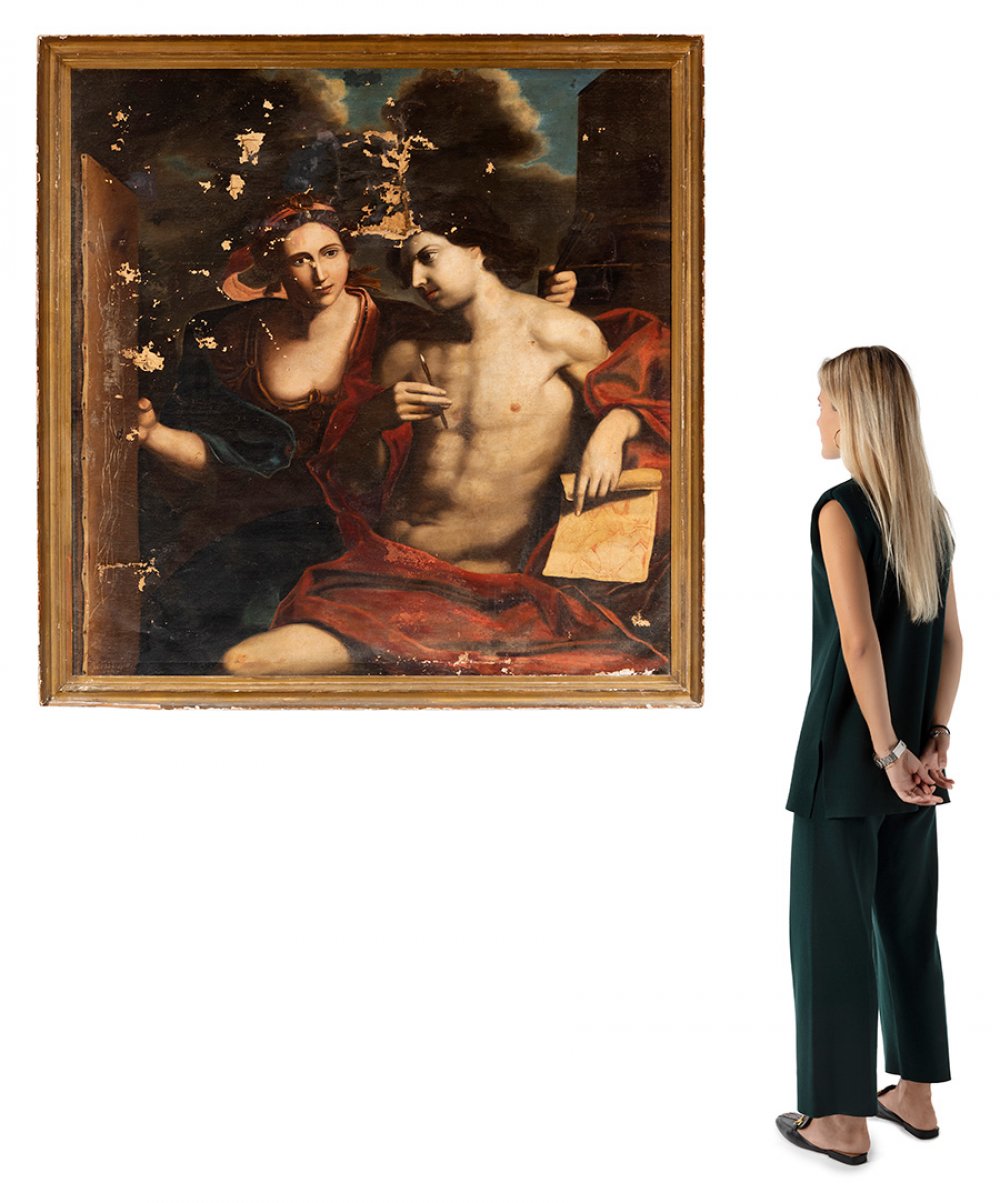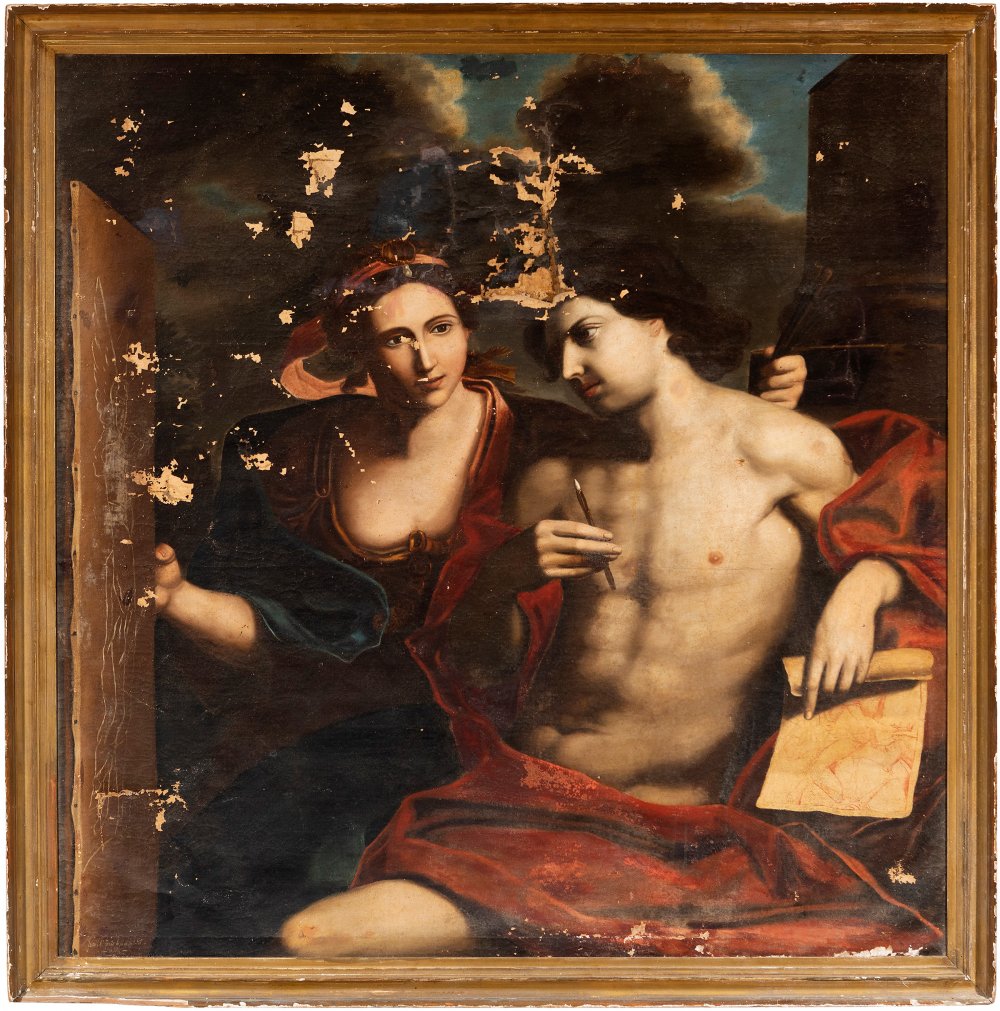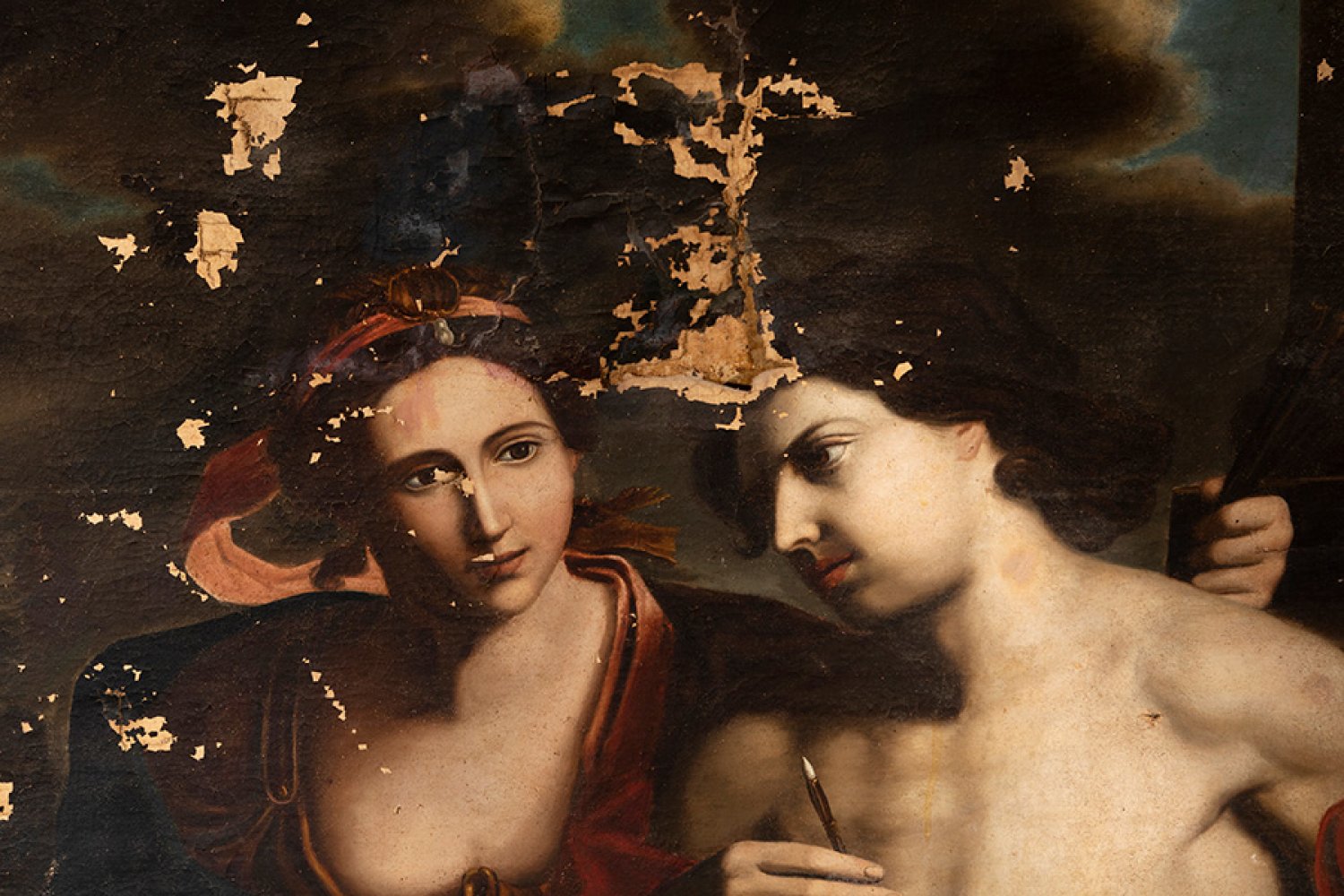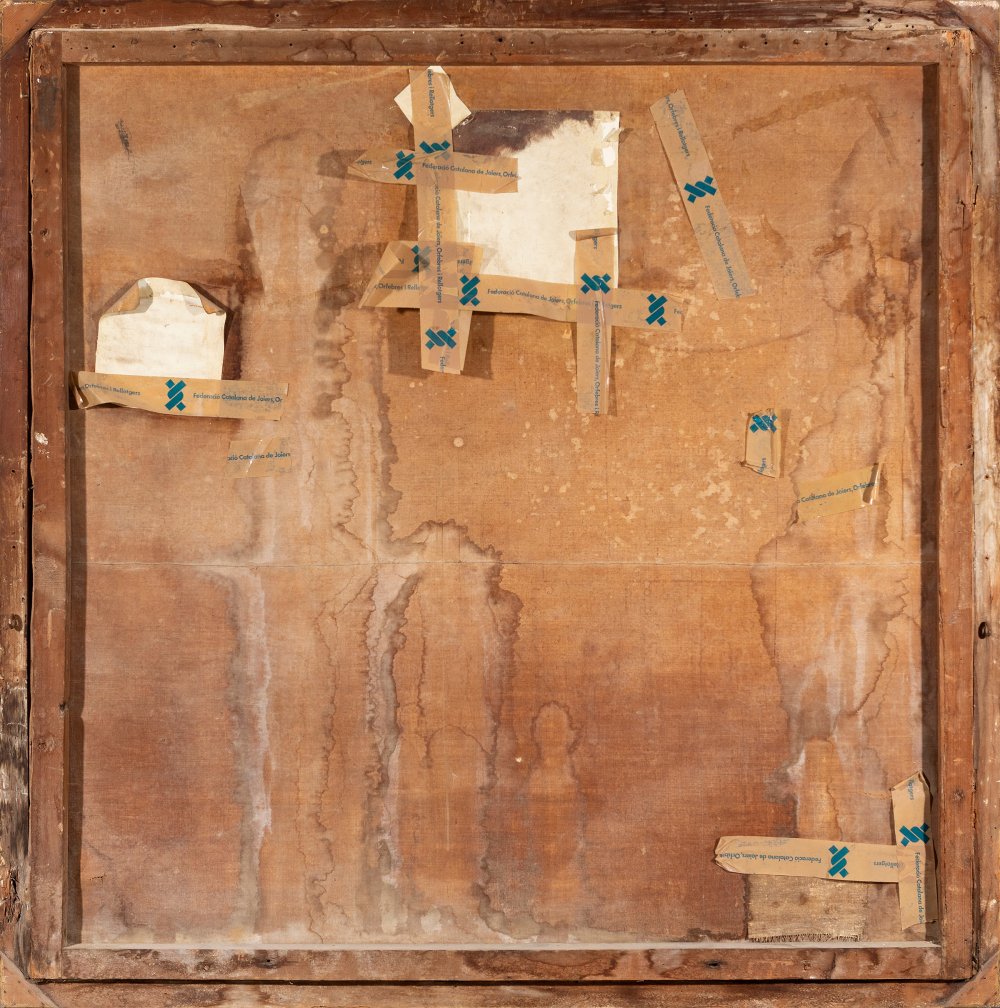55
17th-18th century Bologna School, following models of GUIDO RENI (Calvenzano di Vergato, Bologna,
"Apollo and Kore".
Oil on cotton canvas.
It presents notable faults in the pictorial layer. With patches and restorations.
Measurements: 124 x 122 cm; 133,5 x 130,5 cm (frame).
The present work follows the pictorial models established by Guido Reni and El Guercino, two of the most acclaimed artists in the first half of the 17th century. It is a canvas that reveals the Roman and Romano-Bolognese influence of both artists, with an idealised, classical language, calm, structured compositions, elegant contours and a clear palette rich in pastel tones.
Guercino was born in the village of Cento in the province of Ferrara. The principal influences that shaped his style were the Bolognese; Ludovico Carracci, his cousin Hannibal Carracci and the Ferrara-born Ippolito Scarsella. Apart from a two-year stay in Rome during the papacy of the Bolognese Gregorio XV Ludovisi, he was active in his native town until 1642 when he moved to neighbouring Bologna. He was about twenty-five years old when he came to the attention of his first important clients, among them Cardinal Alessandro Ludovisi, Archbishop of Bologna; Cardinal Jacopo Serra, papal legate in Ferrara; Grand Duke Cosimo II of Tuscany and Duke Ferdinand Gonzaga of Mantua. By the mid-1620s he had turned down invitations to work outside Italy, from Charles I of England among others. He seems to have been reluctant to enter into direct competition with his Bolognese rivals, especially Guido Reni, who from around 1610 was the most celebrated painter in Italy. Most of his abundant output consists of altarpieces and easel paintings, but in the first half of his career he also painted frescoes in Cento, Bologna, Rome (the Aurora on the ceiling of the Casino Ludovisi) and the cathedral of Piacenza (1626-1627). His early "Tenebrist" style is characterised by dramatic lighting, saturated colours and agitated compositions. His stay in Rome led him to gradually modify his style towards a much more idealised and classical language, with calmer and more structured compositions, more elegant contours, a palette generally lighter and richer in pastel tones.
The undisputed master of Roman-Bolognese classicism alongside Albani and Domenichino, Guido Reni was undoubtedly the best of the three. Closely linked to the Carracci family and to the city of Bologna, they all had a similar career. They trained in Bologna with Denys Calvaert, and then went to the Accademia degli Incamminati, directed by Ludovico Carraci. In 1600 Reni arrived in Rome, where he worked with Annibale Carracci in the Galleria Farnese. His best period began in these years; in 1609, on Annibale's death, Reni became the head of the classicist school. In the city he was the protégé of Scipione Borghese, the future Pope Paul V, for whom the painter produced one of his most important works, "La Aurora" (Palazzo Rospigliosi). It reveals something that would always be characteristic of Reni's style, his admiration for ancient sculpture. Starting from classical statues, he developed an ideal of beauty and perfection that would be greatly admired by subsequent painters. In 1614 he returned to Bologna for good. Reni's style evolved in a clear direction, becoming more and more sculptural and cold, more and more fully classicist. His mature work was characterised by a cold, silvery palette. Finally, from the 1930s onwards, his style became sketchy, with an unfinished appearance and a tendency towards monochrome, of great interest from a technical as well as a formal point of view.Guido Reni is currently represented in the most important art galleries all over the world, including the Prado Museum, the Hermitage, etc.
"Apollo and Kore".
Oil on cotton canvas.
It presents notable faults in the pictorial layer. With patches and restorations.
Measurements: 124 x 122 cm; 133,5 x 130,5 cm (frame).
The present work follows the pictorial models established by Guido Reni and El Guercino, two of the most acclaimed artists in the first half of the 17th century. It is a canvas that reveals the Roman and Romano-Bolognese influence of both artists, with an idealised, classical language, calm, structured compositions, elegant contours and a clear palette rich in pastel tones.
Guercino was born in the village of Cento in the province of Ferrara. The principal influences that shaped his style were the Bolognese; Ludovico Carracci, his cousin Hannibal Carracci and the Ferrara-born Ippolito Scarsella. Apart from a two-year stay in Rome during the papacy of the Bolognese Gregorio XV Ludovisi, he was active in his native town until 1642 when he moved to neighbouring Bologna. He was about twenty-five years old when he came to the attention of his first important clients, among them Cardinal Alessandro Ludovisi, Archbishop of Bologna; Cardinal Jacopo Serra, papal legate in Ferrara; Grand Duke Cosimo II of Tuscany and Duke Ferdinand Gonzaga of Mantua. By the mid-1620s he had turned down invitations to work outside Italy, from Charles I of England among others. He seems to have been reluctant to enter into direct competition with his Bolognese rivals, especially Guido Reni, who from around 1610 was the most celebrated painter in Italy. Most of his abundant output consists of altarpieces and easel paintings, but in the first half of his career he also painted frescoes in Cento, Bologna, Rome (the Aurora on the ceiling of the Casino Ludovisi) and the cathedral of Piacenza (1626-1627). His early "Tenebrist" style is characterised by dramatic lighting, saturated colours and agitated compositions. His stay in Rome led him to gradually modify his style towards a much more idealised and classical language, with calmer and more structured compositions, more elegant contours, a palette generally lighter and richer in pastel tones.
The undisputed master of Roman-Bolognese classicism alongside Albani and Domenichino, Guido Reni was undoubtedly the best of the three. Closely linked to the Carracci family and to the city of Bologna, they all had a similar career. They trained in Bologna with Denys Calvaert, and then went to the Accademia degli Incamminati, directed by Ludovico Carraci. In 1600 Reni arrived in Rome, where he worked with Annibale Carracci in the Galleria Farnese. His best period began in these years; in 1609, on Annibale's death, Reni became the head of the classicist school. In the city he was the protégé of Scipione Borghese, the future Pope Paul V, for whom the painter produced one of his most important works, "La Aurora" (Palazzo Rospigliosi). It reveals something that would always be characteristic of Reni's style, his admiration for ancient sculpture. Starting from classical statues, he developed an ideal of beauty and perfection that would be greatly admired by subsequent painters. In 1614 he returned to Bologna for good. Reni's style evolved in a clear direction, becoming more and more sculptural and cold, more and more fully classicist. His mature work was characterised by a cold, silvery palette. Finally, from the 1930s onwards, his style became sketchy, with an unfinished appearance and a tendency towards monochrome, of great interest from a technical as well as a formal point of view.Guido Reni is currently represented in the most important art galleries all over the world, including the Prado Museum, the Hermitage, etc.
28th September - Old Masters
Sale Date(s)
Venue Address
General delivery information available from the auctioneer
Setdart offers Worldwide shipping
PICK UP IN ROOM: You can come and pick up your lots in our offices (Barcelona, Madrid or Valencia). At the moment of the withdrawal, you will be able to accept the current conditions of the lot by means of a document that you will sign.
YOU CAN SEND ANOTHER PERSON TO PICK UP: This person must present a signed authorization that you can find in our web page by accessing from BUY AT SETDART- LOGISTICS-DOWNLOAD AUTHORIZATION DOCUMENT. You can also send an e-mail with the requested data in AUTHORIZATION DOCUMENT to admin@setdart.com
Important Information
25% buyer´s premium
21% buyer´s premium at www.setdart.com
Terms & Conditions
The maximum period to pay the lots is 7 working days. You can pay either via bank transfer or with credit card through our platform www.setdart.com (we only accept VISA or Mastercard).
BUYER´S PREMIUM: 22% Hammer price + 21% VAT from the buyer´s premium
If your piece has more than 100 years, our Ministry of Culture requires an export certificate in order for the piece to leave the country. Note that if the piece goes inside the EU, there is no cost for the export certificate. If the piece goes outside the EU, there is a cost for the export certificate. You can find more information in our Ministry of Culture website: https://www.culturaydeporte.gob.es/en/cultura/patrimonio/exportacionimportacion/exportacion/tasas.html
INQUIRIES: admin@setdart.com
Setdart guides you through the entire process, from the time of award to the day you receive your lot. Our logistics team will be happy to manage your transport, and will advise you on the best shipping method with professionals from the sector used to handling works of art and jewelry.
WE OFFER WORLDWIDE DOOR TO DOOR SHIPPING
PICK UP IN ROOM: You can come and pick up your lots in our offices. At the moment of the withdrawal, you will be able to accept the current conditions of the lot by means of a document that you will sign.
YOU CAN SEND ANOTHER PERSON TO PICK UP: This person must present a signed authorization that you can find in our web page by accessing from BUY AT SETDART-LOGISTICS-DOWNLOAD AUTHORIZATION DOCUMENT. You can also send an e-mail with the requested data in AUTHORIZATION DOCUMENT to admin@setdart.com
SETDART IS NOT RESPONSIBLE FOR THE STATE OF THE PARTS ONCE THEY LEAVE OUR FACILITIES. MRW SHIPMENTS: Once the payment is made, your lot will be packed for shipment, the logistics department will send you an e-mail notifying you of the day it leaves our warehouse, changes of address cannot be made after receiving this e-mail.
INSURANCE INCIDENTS: Coverage for the value of the auction up to 3000 ? per shipment, if the value of the auction is higher, Setdart will send you a quote including the additional insurance. The insurance company WILL NOT BE RESPONSIBLE FOR THE SHIPMENT THAT EXCEEDS THAT AMOUNT AND IS NOT FULLY INSURED. MRW INCIDENTS: Maximum notification 48 hours after receipt, after which the insurance company WILL NOT BE RESPONSIBLE AND NO CLAIMS WILL BE ACCEPTED.
E-MAIL LOGISTICS: logistica@setdart.com
PICK UP YOUR MESSAGES: You can send your own messaging, prior notice via e-mail that your shipment is ready, please note 3 or 4 days in advance. This type of shipment is packaged so Setdart will provide you with a quote.
EXPENSES FOR STORAGE: We inform you that if the purchased lot is not picked up within a month, you will be charged 30€ per week per lot. Setdart Online S.L., owner of the web site "setdart.com", "setdart.net" and "setdart.org", acts as a company of Spanish nationality inscribed in the Volume 36955, sheet 182, page B-293056 of the Mercantile Registry, with registered office at Calle Aragó















